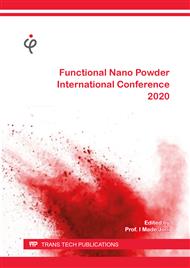p.25
p.41
p.59
p.73
p.81
p.91
p.103
p.113
p.121
The Physicochemical Properties of PVDF/SiO2 Composite Nanofibers for Potential Application of Lithium-Ion Battery Separators
Abstract:
Lithium-ion batteries have the main component include a positive electrode, negative electrode, liquid electrolyte, and membrane separator. The separator was used to secure the battery by preventing it from short circuits. In this paper, the separator PVDF/SiO2 (Polyvinylidene fluoride/Silica) nanofiber membrane was synthesized by double jet sprayers electrospinning method on rotating cylinder collector. The SiO2 colloid nanoparticle concentration was varied at 1000, 2500, and 5000 ppm. The effect of the SiO2 nanoparticle addition to the PVDF nanofiber membrane to improve membrane characteristics, including porosity, high temperature stability mechanical, mechanical strength, and battery capacity stability, were systematically investigated. The PVDF/SiO2 results have a fibrous structure with SiO2 adhering to the fibers' surface. The membrane separator's average thickness is 10.2 micrometers. A large amount of SiO2 addition (SiO2 5000 ppm) on the PVDF nanofibers membrane increased porosity, mechanical properties, and stability at a temperature of 150 °C.
Info:
Periodical:
Pages:
81-87
Citation:
Online since:
August 2021
Authors:
Price:
Сopyright:
© 2021 Trans Tech Publications Ltd. All Rights Reserved
Share:
Citation:


